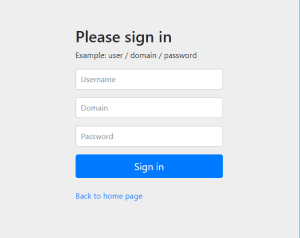概述
在本文中,我们将通过向标准登录表单添加额外字段来实现Spring Security的自定义身份验证方案。
我们将重点关注两种不同的方法,以展示框架的多功能性以及我们可以使用它的灵活方式。
我们的第一种方法是一个简单的解决方案,专注于重用现有的核心Spring Security实现。
我们的第二种方法是更加定制的解决方案,可能更适合高级用例。
2. Maven设置
我们将使用Spring Boot启动程序来引导我们的项目并引入所有必需的依赖项。
我们将使用的设置需要父声明,Web启动器和安全启动器;我们还将包括thymeleaf :org.springframework.boot spring-boot-starter-parent 2.0.0.M7 org.springframework.boot spring-boot-starter-web org.springframework.boot spring-boot-starter-security org.springframework.boot spring-boot-starter-thymeleaf org.thymeleaf.extras thymeleaf-extras-springsecurity4
可以在Maven Central找到最新版本的Spring Boot安全启动器。
3.简单的项目设置
在我们的第一种方法中,我们将专注于重用Spring Security提供的实现。特别是,我们将重用DaoAuthenticationProvider和UsernamePasswordToken,因为它们是“开箱即用”的。
关键组件包括:
- SimpleAuthenticationFilter - UsernamePasswordAuthenticationFilter的扩展
- SimpleUserDetailsService - UserDetailsService的实现
- User - Spring Security提供的User类的扩展,它声明了我们的额外域字段
- SecurityConfig - 我们的Spring Security配置,它将SimpleAuthenticationFilter插入到过滤器链中,声明安全规则并连接依赖项
- login.html - 收集用户名,密码和域的登录页面
3.1. 简单Authentication Filter
在我们的SimpleAuthenticationFilter中,域和用户名字段是从请求中提取的。我们连接这些值并使用它们来创建UsernamePasswordAuthenticationToken的实例。
然后将令牌传递给AuthenticationProvider进行身份验证:
public class SimpleAuthenticationFilter extends UsernamePasswordAuthenticationFilter { @Override public Authentication attemptAuthentication( HttpServletRequest request, HttpServletResponse response) throws AuthenticationException { // ... UsernamePasswordAuthenticationToken authRequest = getAuthRequest(request); setDetails(request, authRequest); return this.getAuthenticationManager() .authenticate(authRequest); } private UsernamePasswordAuthenticationToken getAuthRequest( HttpServletRequest request) { String username = obtainUsername(request); String password = obtainPassword(request); String domain = obtainDomain(request); // ... String usernameDomain = String.format("%s%s%s", username.trim(), String.valueOf(Character.LINE_SEPARATOR), domain); return new UsernamePasswordAuthenticationToken( usernameDomain, password); } // other methods} 3.2.简单的UserDetails服务
UserDetailsService定义了一个名为loadUserByUsername的方法。我们的实现提取用户名和域名。然后将值传递给我们的UserRepository以获取用户:
public class SimpleUserDetailsService implements UserDetailsService { // ... @Override public UserDetails loadUserByUsername(String username) throws UsernameNotFoundException { String[] usernameAndDomain = StringUtils.split( username, String.valueOf(Character.LINE_SEPARATOR)); if (usernameAndDomain == null || usernameAndDomain.length != 2) { throw new UsernameNotFoundException("Username and domain must be provided"); } User user = userRepository.findUser(usernameAndDomain[0], usernameAndDomain[1]); if (user == null) { throw new UsernameNotFoundException( String.format("Username not found for domain, username=%s, domain=%s", usernameAndDomain[0], usernameAndDomain[1])); } return user; }} 3.3. Spring Security配置
我们的设置与标准的Spring Security配置不同,因为我们在默认情况下通过调用addFilterBefore将SimpleAuthenticationFilter插入到过滤器链中:
@Overrideprotected void configure(HttpSecurity http) throws Exception { http .addFilterBefore(authenticationFilter(), UsernamePasswordAuthenticationFilter.class) .authorizeRequests() .antMatchers("/css/**", "/index").permitAll() .antMatchers("/user/**").authenticated() .and() .formLogin().loginPage("/login") .and() .logout() .logoutUrl("/logout");} 我们可以使用提供的DaoAuthenticationProvider,因为我们使用SimpleUserDetailsService配置它。回想一下,我们的SimpleUserDetailsService知道如何解析我们的用户名和域字段,并返回在验证时使用的相应用户。
public AuthenticationProvider authProvider() { DaoAuthenticationProvider provider = new DaoAuthenticationProvider(); provider.setUserDetailsService(userDetailsService); provider.setPasswordEncoder(passwordEncoder()); return provider;} 由于我们使用的是SimpleAuthenticationFilter,因此我们配置自己的AuthenticationFailureHandler以确保正确处理失败的登录尝试:
public SimpleAuthenticationFilter authenticationFilter() throws Exception { SimpleAuthenticationFilter filter = new SimpleAuthenticationFilter(); filter.setAuthenticationManager(authenticationManagerBean()); filter.setAuthenticationFailureHandler(failureHandler()); return filter;} 3.4.登录页面
我们使用的登录页面收集我们的SimpleAuthenticationFilter提取的额外的字段:
当我们运行应用程序并访问http:// localhost:8081上下文时,我们会看到一个访问安全页面的链接。单击该链接将显示登录页面。正如所料,我们看到了额外的域名字段

3.5.总结
在我们的第一个例子中,我们能够通过“伪造”用户名字段来重用DaoAuthenticationProvider和UsernamePasswordAuthenticationToken。
因此,我们能够使用最少量的配置和其他代码添加对额外登录字段的支持。
4.自定义项目设置
我们的第二种方法与第一种方法非常相似,但可能更适合于非平凡用例。
我们的第二种方法的关键组成部分包括:
- CustomAuthenticationFilter - UsernamePasswordAuthenticationFilter的扩展
- CustomUserDetailsService - 声明loadUserbyUsernameAndDomain方法的自定义接口
- CustomUserDetailsServiceImpl - CustomUserDetailsService的实现
- CustomUserDetailsAuthenticationProvider - AbstractUserDetailsAuthenticationProvider的扩展
- CustomAuthenticationToken - UsernamePasswordAuthenticationToken的扩展
- User - Spring Security提供的User类的扩展,它声明了我们的额外域字段
- SecurityConfig - 我们的Spring Security配置,它将CustomAuthenticationFilter插入到过滤器链中,声明安全规则并连接依赖项
- login.html - 收集用户名,密码和域的登录页面
4.1.自定义验证过滤器
在我们的CustomAuthenticationFilter中,我们从请求中提取用户名,密码和域字段。这些值用于创建CustomAuthenticationToken的实例,该实例将传递给AuthenticationProvider进行身份验证:
public class CustomAuthenticationFilter extends UsernamePasswordAuthenticationFilter { public static final String SPRING_SECURITY_FORM_DOMAIN_KEY = "domain"; @Override public Authentication attemptAuthentication( HttpServletRequest request, HttpServletResponse response) throws AuthenticationException { // ... CustomAuthenticationToken authRequest = getAuthRequest(request); setDetails(request, authRequest); return this.getAuthenticationManager().authenticate(authRequest); } private CustomAuthenticationToken getAuthRequest(HttpServletRequest request) { String username = obtainUsername(request); String password = obtainPassword(request); String domain = obtainDomain(request); // ... return new CustomAuthenticationToken(username, password, domain); } 4.2.自定义UserDetails服务
我们的CustomUserDetailsService合约定义了一个名为loadUserByUsernameAndDomain的方法。
我们创建的CustomUserDetailsServiceImpl类只是实现并委托我们的CustomUserRepository来获取用户:
public UserDetails loadUserByUsernameAndDomain(String username, String domain) throws UsernameNotFoundException { if (StringUtils.isAnyBlank(username, domain)) { throw new UsernameNotFoundException("Username and domain must be provided"); } User user = userRepository.findUser(username, domain); if (user == null) { throw new UsernameNotFoundException( String.format("Username not found for domain, username=%s, domain=%s", username, domain)); } return user;} 4.3.自定义UserDetailsAuthenticationProvider
我们的CustomUserDetailsAuthenticationProvider将AbstractUserDetailsAuthenticationProvider和委托扩展到我们的CustomUserDetailService以检索用户。这个类最重要的特性是retrieveUser方法的实现。
请注意,我们必须将身份验证令牌强制转换为CustomAuthenticationToken才能访问我们的自定义字段:
@Overrideprotected UserDetails retrieveUser(String username, UsernamePasswordAuthenticationToken authentication) throws AuthenticationException { CustomAuthenticationToken auth = (CustomAuthenticationToken) authentication; UserDetails loadedUser; try { loadedUser = this.userDetailsService .loadUserByUsernameAndDomain(auth.getPrincipal() .toString(), auth.getDomain()); } catch (UsernameNotFoundException notFound) { if (authentication.getCredentials() != null) { String presentedPassword = authentication.getCredentials() .toString(); passwordEncoder.matches(presentedPassword, userNotFoundEncodedPassword); } throw notFound; } catch (Exception repositoryProblem) { throw new InternalAuthenticationServiceException( repositoryProblem.getMessage(), repositoryProblem); } // ... return loadedUser;} 4.4.总结
我们的第二种方法几乎与我们首先提出的简单方法相同。通过实现我们自己的AuthenticationProvider和CustomAuthenticationToken,我们避免了需要使用自定义解析逻辑来调整我们的用户名字段。
5.结论
在本文中,我们在Spring Security中实现了一个使用额外登录字段的表单登录。我们以两种不同的方式做到了这一点
- 在我们简单的方法中,我们最小化了我们需要编写的代码量。通过使用自定义解析逻辑调整用户名,我们能够重用DaoAuthenticationProvider和UsernamePasswordAuthentication
- 在我们更加个性化的方法中,我们通过扩展AbstractUserDetailsAuthenticationProvider并使用CustomAuthenticationToken提供我们自己的CustomUserDetailsService来提供自定义字段支持。